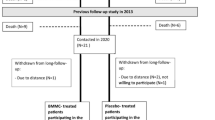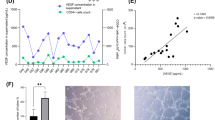Abstract
It is still unclear whether the timing of intracoronary stem cell therapy affects the therapeutic response in patients with reperfused myocardial infarction. The natural course of healing the infarction and the presence of putative homing signals within the damaged myocardium appear to favor cell engraftment during the transendothelial passage in the early days after reperfusion. However, the adverse inflammatory environment, with its high oxidative stress, might be deleterious if cells are administered too early after reperfusion. In addition, current studies use mostly unfractionated cells and it remains to be addressed whether specific cell types, and their enrichment, would be better suited to augmenting the recovery at later time points. Here we highlight several aspects of the timing of intracoronary stem cell therapy and focus on time-related questions that are relevant to the design of future experimental and basic studies.
This is a preview of subscription content, access via your institution
Access options
Subscribe to this journal
Receive 12 print issues and online access
$209.00 per year
only $17.42 per issue
Buy this article
- Purchase on Springer Link
- Instant access to full article PDF
Prices may be subject to local taxes which are calculated during checkout

Similar content being viewed by others
References
Strauer BE et al. (2002) Repair of infarcted myocardium by autologous intracoronary mononuclear bone marrow cell transplantation in humans. Circulation 106: 1913–1918
Assmus B et al. (2002) Transplantation of Progenitor Cells and Regeneration Enhancement in Acute Myocardial Infarction (TOPCARE-AMI). Circulation 106: 3009–3017
Fernández-Avilés F et al. (2004) Experimental and clinical regenerative capability of human bone marrow cells after myocardial infarction. Circ Res 95: 742–748
Wollert KC et al. (2004) Intracoronary autologous bone-marrow cell transfer after myocardial infarction: the BOOST randomised controlled clinical trial. Lancet 364: 141–148
Bartunek J et al. (2005) Intracoronary injection of CD133-positive enriched bone marrow progenitor cells promotes cardiac recovery after recent myocardial infarction. Feasibility and safety. Circulation 112 (Suppl 9): I178–I183
Antman EM and Braunwald E (2005) ST-elevation myocardial infarction: Pathology, pathophysiology and clinical features. In Braunwald's Heart Disease, edn 7, 1141–1165 (Eds Zipes DP et al.) Philadelphia: WB Saunders
Wojakowski W et al. (2004) Mobilization of CD34/CXCR4+, CD34/CD117+, c-met+ stem cells and mononuclear cells expressing early cardiac, muscle and endothelial markers into peripheral blood in patients with acute myocardial infarction. Circulation 110: 3213–3220
Massa M et al. (2005) Increased circulating hematopoietic and endothelial progenitor cells in the early phase of acute myocardial infarction. Blood 105: 199–206
Nian M et al. (2004) Inflammatory cytokines and postmyocardial infarction remodeling. Circ Res 94: 1543–1553
Frangogiannis NG et al. (2002) The inflammatory response in myocardial infarction. Cardiovasc Res 53: 31–47
Abott JD et al. (2004) Stromal cell-derived factor 1α plays a critical role in stem cell recruitment to the heart after myocardial infarction but is not sufficient to induce homing in the absence of injury. Circulation 110: 3300–3305
Lu L et al. (2004) Molecular and cellular events at the site of myocardial infarction: from the perspective of rebuilding myocardial tissue. Biochem Biophys Res Commun 320: 907–913
Deten A et al. (2002) Cardiac cytokine expression is upregulated in the acute phase after myocardial infarction. Experimental studies in rats. Cardiovasc Res 55: 329–340
Li RK et al. (2001) Optimal time for cardiomyocyte transplantation to maximize myocardial function after left ventricular injury. Ann Thorac Surg 72: 1957–1963
Ma J et al. (2005) Time course of myocardial stromal cell-derived factor 1 expression and beneficial effects of intravenously administered bone marrow stem cells in rats with experimental myocardial infarction. Basic Res Cardiol 100: 1–7
Winitsky SO et al. (2005) Adult murine skeletal muscle contains cells that can differentiate into beating cardiomyocytes in vitro. PLoS Biol 3: e87
Assmus B et al. (2004) Transcoronary transplantation of progenitor cells and recovery of left ventricular function in patient with chronic ischemic heart disease: results of a randomized controlled trial [abstract]. Circulation 110 (Suppl III): III–238
Hill JM et al. (2003) Circulating endothelial progenitor cells as novel biological determinants of vascular function and risk. N Engl J Med 348: 593–600
Epstein SE et al. (2004) Janus phenomenon: the interrelated tradeoffs inherent in therapies designed to enhance collateral formation and those designed to inhibit atherogenosis. Circulation 109: 2826–2831
Vanderheyden M et al. (2005) Accelerated atherosclerosis following intracoronary haematopoietic stem cell administration. Heart 91: 448
Janssens S et al. (2005) Transplantation of autologous bone marrow-derived stem cells in patients with ST segment elevation myocardial infarction [abstract]. Circulation 112 (Suppl 2): II–632
Strauer BE et al. (2005) Regeneration of human infarcted heart muscle by intracoronary autologous bone marrow cell transplantation in chronic coronary artery disease: the IACT Study. J Am Coll Cardiol 46: 1651–1658
Author information
Authors and Affiliations
Corresponding author
Ethics declarations
Competing interests
Jozef Bartunek, William Wijns, Guy R Heyndrickx and Marc Vanderheyden are all members of the Cardiovascular Research Aalst, a nonprofit foundation promoting clinical and translational research at the Cardiovascular Center, OLV Ziekenhuis, Aalst, Belgium, and is a founding member of Cardio3, a start-up company working in the field of cardiac stem cells.
Rights and permissions
About this article
Cite this article
Bartunek, J., Wijns, W., Heyndrickx, G. et al. Timing of intracoronary bone-marrow-derived stem cell transplantation after ST-elevation myocardial infarction. Nat Rev Cardiol 3 (Suppl 1), S52–S56 (2006). https://doi.org/10.1038/ncpcardio0417
Received:
Accepted:
Issue Date:
DOI: https://doi.org/10.1038/ncpcardio0417
This article is cited by
-
Bone marrow mesenchymal stem cells transfer in patients with ST-segment elevation myocardial infarction: single-blind, multicenter, randomized controlled trial
Stem Cell Research & Therapy (2021)
-
The epicardial delivery of cardiosphere derived cells or their extracellular vesicles is safe but of limited value in experimental infarction
Scientific Reports (2021)
-
Pharmacokinetic Advantage of ASD Device Promote Drug Absorption through the Epicardium
Pharmaceutical Research (2020)
-
Delayed administration of allogeneic cardiac stem cell therapy for acute myocardial infarction could ameliorate adverse remodeling: experimental study in swine
Journal of Translational Medicine (2015)
-
A reagent to facilitate protein recovery from cells and tissues
Drug Delivery and Translational Research (2012)



